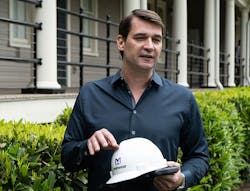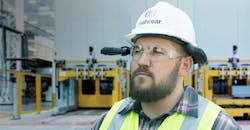Industrial AR Crosses Chasm: RealWear Hits Milestone
Today, RealWear, Inc. announced it has landed $80 million in Series B funding from notable investors including Teradyne, Inc., Bose Ventures, Qualcomm Ventures, and JPMorgan Chase & Co. Series A ($20 million) was led by Columbia Ventures Corporation.
It's a huge milestone for the relatively new Augmented Reality startup, which started shipping its voice-operated HMT-1 (head-mounted tablet) in the summer of 2017. So far, they have sent out 15,000 units, which run on Android OS and have enabled more than 120 different production-augmenting apps. The use cases are growing exponentially in number and scale. Recently, BMW made a deal with RealWear and software partner Ubimax to deploy the HMT-1 at all 347 American BMW service centers to aid in maintenance and repair. Earlier this year, Shell announced it would use the intrinsically safe version, the HMT-1Z1, at 24 of its sites.
For an in-depth piece on how the HMT-1 has been used in manufacturing, vist our sister site New Equipment Digest.
As broadly as the specific applications can differ, they generally revolve around the three major categories: connecting with remote experts, displaying work instructions, or visualizing data.
Several other devices do the same, from Google Glass Enterprise Edition to HoloLens. Both of those tech giants already have improved industry-centric 2.0 versions, the market the Vancouver, Washington-based RealWear went at from the beginning. So in a way, they were playing catchup to RealWear, which has no intention of slowing down or yielding its approximate 50% market share. That extra $80 million is the company's way of taping rockets to roller skates to blast ahead into uncharted territory for AR, but well-worn for past computing devices. The plan has two major parts: First, perfect the IT infrastructure that will allow enterprises to scale safer and easier. And second, create a subscription-based model to allow any company in the world to get their hands on—and heads in—a device that immediately connects the advantages of the digital transformation directly to workers without a huge capital expenditure or months of training.
In that way, this isn’t just a big step for RealWear; it's a giant leap for AR over the trough of disillusionment. No one is more hyped about the news than Andy Lowery, the energetic AR evangelist at RealWear's helm. The CEO previously managed the nuclear propulsion operations for the USS John Stennis aircraft carrier and was president of DAQRI, an early entrant into the industrial AR world. We spoke with Lowery after the news was announced to talk about RealWear's trajectory and how it will impact businesses looking to leverage AR.
IW: What does this funding say about the AR industry?
Andy Lowery: AR emerged circa 2013 seemingly out of nowhere. And what we then saw was we saw a flurry of AR investments, almost like piranhas. Anyone who had a unique player or slant or software or hardware, funding came very liberally too, and that includes DAQRI, my first company.
More recently there's' been an awakening of a real perspective. The hype cycle for us has come and gone. We're not talking about pilots anymore. It's all about deployments.
The people that diligenced RealWear are folks that would never come in early to an investment space, except for Qualcomm. Bose and Teradyne don’t typically look at companies that aren’t cash-flow positive and growth-oriented. Same is true of J.P. Morgan.
The result of these investments will be really a new class of products. Zebra [Technologies] is looking into the space, Glass emerged recently with a $999 level product, and HoloLens continues to invent and advance in the industrial dimension.
IW: So are you saying you're in the slope of enlightenment now?
AL: We really are. This particular device class has crossed that chasm. Now we're taking a look at enabling and bundling, finding ways to deploy faster.
The challenge that we’re facing is the ability to deploy tens of thousands of systems in a way that's safe and secure and stable. All these dams are about ready to break but there's one little thing we need to tweak. That means the system integration infrastructure, like mobile device management, and security that goes with putting devices on proprietary networks. All of those things are the hard, heavy lifting we're doing as a company.
IW: What will you do with the new influx of money?
AL: We're working on these very final steps with these big enterprises to get to the ten or twenty thousand-piece deployment level. It's not around questions if this will save us money. We're way beyond those conversations. We have program managers talking about customers, intentions to go to scale, budget and executive sponsors. These are the conversations we're trying to manage. It's super exciting that we're entering into this phase of supreme exponential growth as we're getting this in.
It's all timed like a symphony coming to a crescendo at the perfect moment for us.
And what you'll see our focus on, and some of the spend on this quarter is initiating RealWear as-a-Service. We'll begin to bundle software and devices as a service, and we have the finances and bank relationships to support that now to allow people to subscribe.
IW: What made you want to go the "As-a-Service" route?
AL: There's a necessity to bundle an offering and make it so bloody simple for mining companies in Argentina or Chile that want them on 1,000 employees, but can’t pay for them upfront because they are running on low margins. We just charge $50 per person and they order 1,000 immediately. It becomes an accelerant for our ability to get to scale. One or two uses they start seeing ROI and pretty soon they pay for the device on the savings they have.
And take a look at modularity of head-worn systems. Every day I see a new optical waveguide company coming out of stealth that's going to change everything. I just read about one that doesn't have a lot of details, but they claim to have the highest pixel density of any display for near-eye in the market. You get those things coming out every other day, how do you develop a stable enterprise product that will last three to six years, which is what enterprises are expecting? You can’t do it with this consumer "let's-jump-on-the-next-shiny-bauble" methodology and approach. So I had to blend both worlds. Instead of releasing an HMT-2, that would have a set of fixed features, I would make it more modular.
You could get a configuration that looks like the HMT-1 with all the upgrades, but you could also get one with a see-through display or camera or cellular band of your choice and start to use an accessory model like you did with the old desktop computers. That way you could maintain the consistency of the computers. That way you don’t have to switch the device out every time you have a new application that requires 5G, or a thermal camera or some see-through paradigm.
IW: The AR/VR space is projected to have insane growth. Zion Market Research says CAGR will be 63% between this year and 2025. I imagine these devices and the various helpful hands-free applications could be of great use to contractors and DIYers. Thoughts?
AL: That would be a magnificent outcome. I remember talking to someone from the AFLCIO about making union folks mentors for freelancers and the unions getting a fee. The same model can be used here. Rent an HMT from Home Depot with a water heater kit, and pay a little fee to a retired master electrician sitting at home on a tablet to help as needed. That is definitely an outcome that we're aiming for.
IW: From a leadership perspective, what do you attribute the reason for success?
AL: In aggregate, you need a great product, great timing, great people. For Realwear, we've taken a great product that has had more trials and tribulations, from starting out as the Kopin's Golden-i [wearable device] in 2007. No one has had that amount of detailed focused feedback and had time to iterate off of that.
And secondly, our timing could not be better. Right when the world is starting to think digital, we show up on the scene.
There is a bit of fate, there's serendipity and a lot of luck. And luck being of course opportunity meets perspiration.
Now, where do we go? All of our mindshare is spent 100% on trying to stay ahead and be better than the competition and maintain and grow the market percentage. We'll need to occupy all sorts of use cases, or at least have an answer for them.
You have to come into businesses with an identified solution, somewhat preconfigured. You want to leave them a little bit of optionality and have plug-and-play options, but I'm finding out you don’t want to lead with a science fair project with these big businesses and say I have the hardware and here are 120 different applications. Let's figure out which ones you want. It's a much better route to market to say, "Here's my recommendation, this is the whole package, this is who trains." And that's what we're going to test out this quarter.
About the Author
John Hitch
Senior Editor
John Hitch writes about the latest manufacturing trends and emerging technologies, including but not limited to: Robotics, the Industrial Internet of Things, 3D Printing, and Artificial Intelligence. He is a veteran of the United States Navy and former magazine freelancer based in Cleveland, Ohio.
Questions or comments may be directed to: [email protected]


